
DATAMATH CALCULATOR MUSEUM
 |
DATAMATH CALCULATOR MUSEUM |
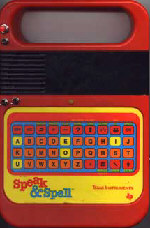 |
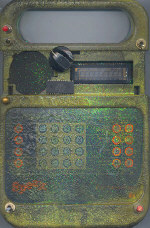 |
 |
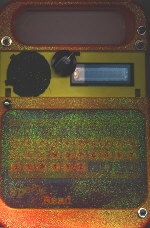 |
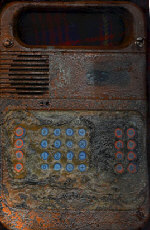 |
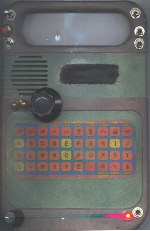 |
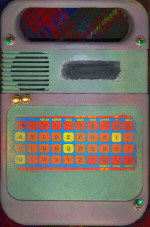 |
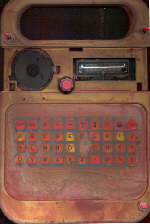 |
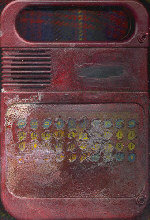 |
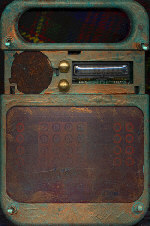 |
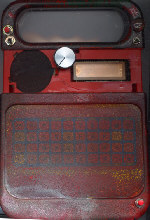 |
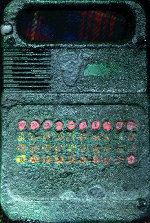 |
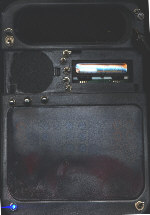 |
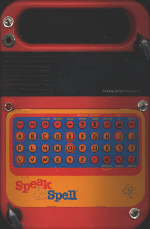 |
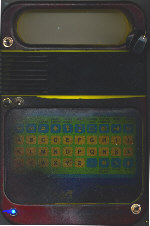 |
© Courtesy of most pictures is Dave Wright of carrionsound.
The process of circuit-bending involves taking cheaply available electronic soundmaking toys and adding extra wires, knobs and switches to make new connections between parts of the internal circuitry and chips.
The roots of circuit-bending can be traced back to 1966 or 1967, when Reed Ghazala recorded using modified electronic devices. Since then Ghazala has continued to record and has written a number of articles on the process of circuit bending. He has also built a number of circuit-bent devices for artists including Tom Waits, Peter Gabriel, King Crimson's Pat Mastalotto, Faust, Chris Cutler, Towa Tei, Yann Tomita, Peter Kember (Sonic Boom), Blur and many others.


 Of
the recent explorations of circuit-bending, Sonic Boom's Data Rape, recorded
under the "Experimental Audio Research" ("EAR") banner and
available through Space Age Recordings, stands out as the most distinctive. The
entire LP was recorded using modified Texas Instruments Speak
& Spell devices, together with some audio processing using a Morley
phaser and an EMS VCS3. Speak & Spell was the first in a series of
educational toys that was to establish electronic speech synthesis in the mass
market. Subsequent products included the less successful, and therefore rarer, Speak
& Math, and the downright obscure Speak
& Read.
Of
the recent explorations of circuit-bending, Sonic Boom's Data Rape, recorded
under the "Experimental Audio Research" ("EAR") banner and
available through Space Age Recordings, stands out as the most distinctive. The
entire LP was recorded using modified Texas Instruments Speak
& Spell devices, together with some audio processing using a Morley
phaser and an EMS VCS3. Speak & Spell was the first in a series of
educational toys that was to establish electronic speech synthesis in the mass
market. Subsequent products included the less successful, and therefore rarer, Speak
& Math, and the downright obscure Speak
& Read.
"Under the pressures of circuit-bending, nearly
every electronic audio device that exists is an experimental musical instrument
waiting to happen. Audio toys, such as the talking Speak & Spell educational
game, are packed with complex sound-producing circuitry that can easily, by
anyone, be nudged off the edge of their theory-true world. This opens up a
wonderland of alien voices that can both inspire and illustrate new compositions."
-Reed Ghazala
 |
Press the
Play button and listen Speak & Spell tunes. Find more sound samples in the DOWNLOAD section. Powered by Yahoo Media Player. |
Reed Ghazala again is the artist behind the well
known Incantor and Trigon Incantor circuit-bent synthetic human voice generators.
The Incantor is based on either the original Speak & Spell or
one of ist sibblings called Speak & Math or Speak & Read. After the
modifications the new control set includes:
• Master Pitch Dial. This sets the pitch of
voices or the tempo of loops.
• Body Contacts. These two brass balls conduct
electricity through the player's flesh. They allow the musician to add
vibrato and pitch-bending to the voices.
• Four Looping Controls. These include:
| • A push-button for searching for loops.
This is pressed while audio is in progress, it stopping the flow and
creating endlessly varied loopings of audio events... tones, phonemes, words, etc. • A toggle switch for locking the above-found loops in place. • An electric eye for incrementing loops forward with a hand shadow (a hand is waved over the Incantor to change the chance loops). • An on/off switch for the electric eye. |
The case is finished to further the impression of these instruments as living beings. Various organic textures, patterns and colors are applied. The original smoked plastic window is removed from the unit to expose the fluorescent blue alpha-numeric display and the speaker housing. This combination of bare-bones structure and complex organic coating creates an entity that speaks a distinct personality even when silent.
You’ll find a lot of information, diagrams and pictures on his website. A first inside view of the Speak & Spell and lots of technical information could be found here.
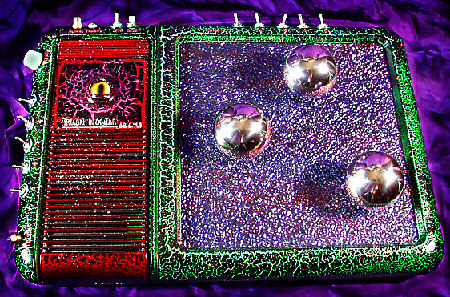
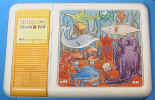 His
Trigon Incantor is based on based on a heavily modified Touch
& Tell educational toy, which is spray-painted, adorned with switches
and on which rest a number of enormous steel ball-bearings. By repositioning the
2" steel balls on the pressure-sensitive stage, you can adjust the speech
and tone patterns generated by the instrument. In addition the Trigon Incantor
uses a single body contact for pitch-bend: a tiny brass ball is simply touched
with the fingertip to impart a nice vibrato in rhythm with the finger pressure
-- the way a violinist rocks a finger on the string.
His
Trigon Incantor is based on based on a heavily modified Touch
& Tell educational toy, which is spray-painted, adorned with switches
and on which rest a number of enormous steel ball-bearings. By repositioning the
2" steel balls on the pressure-sensitive stage, you can adjust the speech
and tone patterns generated by the instrument. In addition the Trigon Incantor
uses a single body contact for pitch-bend: a tiny brass ball is simply touched
with the fingertip to impart a nice vibrato in rhythm with the finger pressure
-- the way a violinist rocks a finger on the string.
Reed Ghazala again is the artist behind the well
known Incantor and Trigon Incantor circuit-bent synthetic human voice generators.
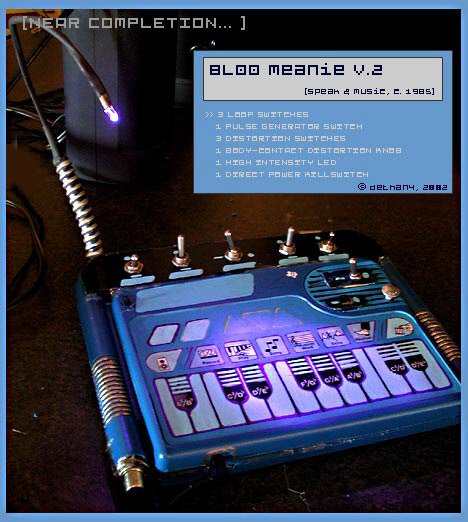 At first
glance it seems easy to bend other products as the Speak & Spell or Touch
& Tell. Dismantling later products like this
Speak & Music introduced in
1986 reveals a different architecture of the electronics. Instead the original
„pliable“ TMSxxx you’ll locate the modern TMP50C40 speech synthesizer
chip.
At first
glance it seems easy to bend other products as the Speak & Spell or Touch
& Tell. Dismantling later products like this
Speak & Music introduced in
1986 reveals a different architecture of the electronics. Instead the original
„pliable“ TMSxxx you’ll locate the modern TMP50C40 speech synthesizer
chip.
 |
Press the
Play button and listen Bloo Meanie. Find more sound samples in the DOWNLOAD section. Powered by Yahoo Media Player. |
Speak & Spell Tunes |
| I'm A Rhythm Machine |
| Composer: | MAS 2008 |
| Contact info: | Twilight 76 Records |
| Permission by: | Rick Sadlowski |
Blue Meanie Tunes |
| Path of Logical |
| Composer: | tOYBREAKER ::: |
| Contact info: | dethany |
| Permission by: | dethany |
Biography:Biography:
The
heads behind MAS 2008 (René Kirchner & Ive Müller) are also known from
projects like Electronic
Corporation and h.e.i.m.elektronik (also Ive and René).
In short words:
∑ Agents in Mission since 1995 in different projects
∑ Style: Detroit Techno, Detroit Technobass, 80ies Wave and EBM influenced
Electro
∑ Influences: Front 242, Depeche Mode, Kraftwerk, Keith Tucker, UR and
Detroit Electro/Techno
Playing live for René and Ive means no harddisc, no computer, no cd or dat on
stage. Since 1999 their concept of making a livegig, as alive, as an electro act
like them could be, is doing a midi-realtime-setup having nearly all their gear
on stage. They are doing a whole new mixdown of their prepared electro and
techno tracks on stage, influenced by the audience of the club. Each gig is not
over before 1,5 hours improving their 808 and 909 as seen in their videoclip
“step into the parallel”.
Discography:
12" Vinyl "Spacelab" released under the name AERODYNAMIX -
Electrocord, Köln, 1997
12" Vinyl "Battlefields In Space" - Dodge, Bochum, 1997
12" Vinyl "Mad In Germany" - Twilight 76, Detroit, 1998
12" Vinyl "Conterminated Material" - Twilight 76, Detroit, 1999
12" Vinyl "Telephoneline" - Electrocord, Koln, 1997
12" Vinyl "Grand Puh Bahs" Sampler - Throw Records, Detroit, 2000
12" Vinyl "Robotek EP" - Subkrauts, Waltrop, 1998
CD-Album "Metamorphosis" - Dodge, Bochum, 2000
CD-Album
"De-cyphered music" - Elektrolux, FFM, 2000
12" Vinyl "Agents In Mission" - Elektrolux, FFM, 2001
CD-Album “Punished By Machines” – Mikrolux, FFM, 2002
©
by mikrolux, 2002
Biography:
If you have additions to the above article please email: joerg@datamath.org.
© Joerg Woerner January 25, 2002. Courtesy of the pictures and parts of the text is Qubais Reed Ghazala and a lot of other circuit-benders. Thanks to all! Their appearances on this site are for informational, non-profit use, and may not be redistributed without expressed written consent.